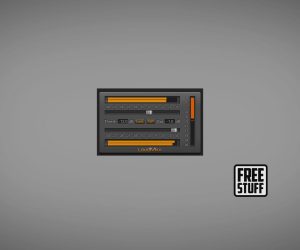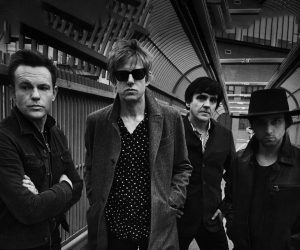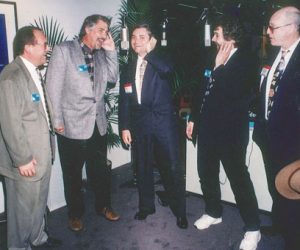
DMA’s Love For DIY
When DMA’s guitarist, Johnny Took’s, relationship ended, he replaced his girlfriend with audio gear and made a Britpop-inspired album with a singer who’d never heard his voice recorded.

Artist: DMA’s
Album: Hills End
The emptiness inside DMA’s guitarist, Johnny Took’s bedroom needed to be filled. A new love to replace one he’d just lost.
When he and his girlfriend had moved into their Newtown sharehouse in Sydney, they’d commandeered the largest room — there being two of them and all. Now that they’d broken up, Took was alone and getting swallowed up by the empty space. So he did the only thing a musician can do; he filled it up with gear! “When she f**ked off, I replaced her with a recording studio and drowned my sorrows in audio gear,” said Took. “It was pretty conducive to writing tunes too.” It was the start of a three-year DIY process that’s resulted in the DMA’s debut album, Hill’s End. It’s a 10-song collection with heavy traces of Britpop, including the necessary bits; killer choruses and a singer with that sound.
The DMA’s style fell into place almost by accident. Both Took and Matt Mason, also a guitarist, played together in a bluegrass band called Little Bastards. It sounds like a big leap to Britpop, but Took says it didn’t take much. Even the songs were interchangeable, Little Bastard used to play So We Know before it was added to the DMA’s repertoire. “The tunes were always there,” he said. “The only thing that made it sound Britpop was Tommy’s voice. Then you just replace banjos and fiddles with noisy as f**k guitars.”
That’s Tommy O’Dell, the DMA’s singer who was previously the drummer in another band — this time psych-rock — Took used to play bass in. “I remember Tommy was asking about a part in a song and started to sing it,” recalled Took. “I thought, hold on this guy’s a better singer than both these dudes and he’s behind the kit.”
Took didn’t do anything about it at the time, but early on in Took’s recording endeavours O’Dell dropped by, and seeing that Took was working on a new folk tune asked if he could have a stab at singing it. O’Dell had never heard his voice before, said Took: “He said, ‘Wow, do I really sound like that?’ ‘Yeah dude, f**kin’ oath!’ It was the reason it all started, from there we just started writing tunes together.”
It’s more than just the tone and style that O’Dell has nailed, it’s the intangibles too. “You can give him a basic melody, and he’s naturally going to put his own inflections on it,” said Took. “He’s got a great pop sensibility. He’s one of those guys who you can play any chords to and he’ll pump out something pretty huge.
“He used to be a painter — not like Van Gogh — and he would record phone voice memos on the job then bring them to Mason and I to work out the chords. He came home from work one time, and he could only play three chords on a guitar, so he’s playing Em to G. He says he’s been working on a new song and starts singing Lay down, give me… then struggles to form a G …something new. We thought, ‘whoa, that’s pretty sick’ and finished that tune in the next 15 minutes.” It became one of their latest singles, Lay Down.
For three years DMA’s was just another side gig. The three of them kept playing in other bands while they recorded more tunes, and it wasn’t until their circle of friends started talking and asking about DMA’s that they thought something could come of it.

TOOK TO IT EASY
Took wasn’t always sure he wanted to record his own material. When he finished school, his old man bought him a handful of recording gear — an interface, Digital Performer 5 and a Rode NT1. He messed around for a few years, but it wasn’t until he hit his 20s and living in The Cross that he started to get serious. The move to Newtown just made it official.
“The main reason I got into it was that I found it was the best way to write songs,” explained Took. “If you’re wondering if a part will sound good, you just grab it and cut it.” Took says the DMA’s have a name for their songwriting process: “We call them drum machine anthems. Either in Ableton, or Boom in Pro Tools, we’d pull up some simple beats, and build it up from there. On the EP, we did the drums last. We’d record the whole song to click tracks, and work off our old sessions.
“I use Pro Tools now, and I’ve been slowly accumulating gear. With our EP and album recording budgets, I’ve just been purchasing gear to make more albums rather than going to a real nice studio.”
These days he’s got a re-racked pair of Quad Eight channel strips he bought off Richie Belkner at Free Energy Device Studios, a UA LA610 channel strip, and a handful of mics. He mostly recorded the album, including some drum takes with his Coles 4038 ribbon (“alone a pretty amazing drum sound”), an AKG C414 and a Shure SM57 on snare.
All the drum tracks were recorded differently. They recorded a number of bed tracks at producer/engineer Dylan Adams’ Coogee studio, mainly so Took could be free to create instead of plugging things in. But the drum takes for the song, Blown Away, were recorded in Took’s bedroom using just those three mics. “Liam, our drummer now, played on most of it, but Tommy actually played drums on that one,” said Took. “30 seconds into the drum take, bloody John Velvet, this wanker hairdresser living below me calls me up and starts abusing me. Which is bulls**t, because I’d been in that space for five years. He’d only moved in four months before and ended up getting me evicted. Still, we ended up using that drum take. I just chopped it up. If it works, and it sounds good, f**k it.”
It’s a pretty good motto, and the edited take fit perfectly with the song. The slight variations from hats to ride added just enough movement to another ‘drum machine anthem’. “It’s been mix ’n’ match,” said Took about the drum sounds. “But the final result kind of sounds the same. Which is the sign of a good mixer. Spike Stent is so good. He’s a wizard.”
That’s Spike Stent, who’s mixed everyone from Beyonce, to Coldplay, Ed Sheeran’s X, Madonna, and Britpop stalwart’s Oasis.
“When I first met him,” said Took. “I was on the Santa Monica pier playing a show and I was a bit pissed. I was saying, ‘oh dude, I didn’t have that much gear.’ I was freaking out because he probably works with people who go to lots of studios and use the best stuff. I was ranting on a bit and he patted me on the shoulder and said, ‘Johnny mate, don’t worry, I’ll make it sound good.’ Which is exactly the reassuring stuff you want to hear from someone mixing your debut album.”

BRITPOP GUITARS IN CHORUS
Took isn’t a stickler for mic position, he’s more interested in the sound that’s coming out of the instrument. “As long as I’ve got all my pedals and my guitar’s going down, I’m sweet,” he said. He typically uses two mics to record his electric, the Shure SM57 and AKG C414 in figure eight shoved right up on the speaker and feeding his pair of Quad Eight 403s.
“We were using an Orange cab with a Fender head for a while in the studio,” said Took. “We also used those Roland Jazz Choruses. I love those amps, they’re so clean and you can actually hear the pedals. We play them pretty loud. It depends on what you’re going for, but you have to turn them up to get them sounding how you want them.”
At one point, towards the end of the recording, he even DI’d his electric guitar straight into the Quad Eight. “You try and make sure every part’s not recorded through the same amp or pedals, otherwise everything just starts sounding the same,” explained Took. “At the end point of the album, when you need something refreshing, it was nice to get away from the amp.
“Most of the distortion is a Tubescreamer TS9, which is a great studio distortion because it’s quite inoffensive and can be textural but ballsy. I also had a Harmonic Percolator for a bit and I use a Maxon Chorus.
“I use the Line6 DL4 delay for some funky things, and the Boss DD7 for textural stuff. I steered away from those Boss digital delays for ages, because I wanted to find something crazier but ended up coming back to it recently.
“The hardest thing about recording is learning to make the stuff you can’t really hear. There’s the guitar parts in the foreground, but all the guitar parts in the background — the textural stuff — are my favourite. The Line6 Auto Volume Echo is good for making guitars sound like synths. If you mix that with the DD7 and the modulation setting on the Hall of Fame reverb, you can pretty much make the guitar sound like a synth pad. Because the acoustic guitar is so rhythmic and always playing the chords, you can get away with that sound on the electric. You’re not really sure what that sound is — it’s a bit paddy, airy, and makes it all kind of washy.”
Acoustic guitar drives a lot of DMA’s tunes. Partly because it’s such a hallmark of the Britpop sound, but also because most of the songs are written with just a drum machine, vocal and acoustic. “I can’t really record with any acoustic guitar other than a Gibson J100,” said Took. “I’ve used some dreadnoughts, even some some nice Gibsons, and small bluegrass guitars, and they all sound a bit too thin and bright for me. I like a real warm, lush acoustic sound that wraps around your head. Acoustic guitar can be quite nostalgic, which I like. It’s kind of dreamy and ballady.” Again, he tries not to overthink the mic positions; he just puts the C414 up in front of the guitar and plugs it into the Quad Eight. “Sometimes I don’t really know what I’m doing,” said Took. “Which, to be honest, in some ways is a good thing. Occasionally you can be too deep and think about it too much. At the end of the day, a s**t recording of a good song is going to trump a good recording of a s**t song.”
SPIKE FINISHES IT OFF
Took didn’t want to simple rely on good songs for their debut, he wanted the end result to sound like it was far beyond his bedroom. “I was a bit worried,” said Took. “When you record the way we do, it’s so easy to have this washy DIY sound. It can sound cool and I love that stuff, but it’s not what I wanted for this first album. Spike really stepped up and made everything sound great, with a beautiful sense of space. There are a lot of guitar parts in there I’d almost forgotten were there; in particular, really interesting parts that Mason had played.
“And the drum sounds he got from some of the garbage I gave him were amazing. I’m being harsh on myself, but he made some incredible drum sounds. Everything sat together perfectly. It was so stressful at first, because we were doing it on the road via email. Everyone’s really silent in the van, but freaking out over email. No one’s saying anything, but they’re all typing, ‘OMG!’ After the first couple of songs, he understood what we were going for, and it was so much easier to mix the rest of the album.
“I was also getting pretty sick of the songs until he started mixing them. He brought back that love for our own tunes, remembering why we wrote those songs, and I really thank him for that.”















RESPONSES